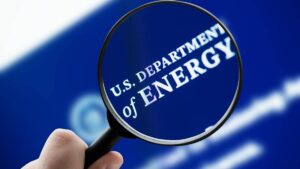China has hydrogen in its sights

Development of hydrogen resources may become a national issue in China next year, potentially complicating or complementing Australia’s plans for the industry.
A “strong and rising opinion” at this year’s ‘Two Sessions’ National People’s Congress and Chinese People’s Political Consultative Conference were for hydrogen to feature in next year’s 14th five-year plan, said Wood Mackenzie Asia Pacific vice chair Gavin Thompson.
The idea would be for the state to back investment in technology and supply chains.
The sentiment came from a push this year at the national political event to put energy security back on China’s agenda and reduce reliance on imported oil and its volatile prices, and coal.
Renewables are likely to benefit because they pose no supply chain or fuel security risks, Thompson says.
China mentioned hydrogen once in its 13th five-year plan in 2016, under the ‘development of strategic emerging industries’ section.
With China’s huge capacity for establishing and financing new industries, it could become a thorn in Australia’s goal of becoming an exporter of green hydrogen to Asia.
What it’ll take for Australia to export hydrogen
McKinsey, a consultancy, among others believes Australia could have a large enough hydrogen industry for exports around 2040 if it starts building now.
Mckinsey senior expert Godart van Gendt said last year the cost of building electrolysers — the technology that separates the oxygen and hydrogen molecules in water — will come down by 70 per cent over the next decade.
Using an energy price of $20 per megawatt-hour (MWh) in Australia, plus shipping, handling and liquefaction, making and getting hydrogen to Japan will cost $3.30/kg — or $25 a gigajoule (GJ). At the time, that was three times the current price of LNG in Australia and Japan.
Japan power prices would need to remain at or above $60/MWh by 2040 to make Aussie hydrogen imports financially viable, or a $100/tonne carbon price.
Beaten to the punch
China’s 14th five-year plan, to be issued next year for 2021-2025, is expected to shape the global economy and energy use.
“I think this will be one of the most important political documents of our time. This is no exaggeration. The direction China takes over the next five years will, in many ways, help define the post-pandemic future,” Wood Mac’s Thompson said.
Indications of where that plan is headed have been flagged over the last few months, and hydrogen is increasingly part of the mix.
A white paper issued by the government late last year shows the Chinese Communist Party expects home-made hydrogen to make up 10 per cent of its energy needs by 2050, with a focus on transportation and industrial uses.
“With the increasing consumption of fossil fuels and the dwindling reserves of these resources, there is an urgent need to find a new and abundant energy source that does not depend on fossil fuels. Hydrogen energy is a kind of new secondary energy which is expected to solve the conventional energy crisis,” an academic paper said this year, reflecting the political push towards self-sufficiency in energy.
Until now China has not focused on hydrogen. Support for fuel cell vehicles was to be turned off this year, while promises to decarbonise transportation relied on electrification.
China rises, again
The recent emphasis has been on self-sufficiency — a rising issue in China’s political class Thompson says — rather than exports.
But a super-charged hydrogen industry in that country which becomes big enough for an export industry would have implications for Australia’s ambitions to export its own hydrogen to Asia.
Australia’s goal, as outlined by retiring chief scientist Alan Finkel, would be to sell green hydrogen made using renewable energy to countries such as Japan and South Korea which are looking for new energy sources as well as ways to bring down their carbon dioxide emissions.
Ideas for domestic use of hydrogen have so far been limited to heavy transportation, and an idea put forward by the Grattan Institute for the government to fund a speculative steel making plant that could switch to hydrogen once an industry was set up.
Australia has no hydrogen industry today but politicians on both sides of the centre line federally and in the states are keen to set up a “green hydrogen” sector fuelled by renewables, but potentially kicked off by “brown hydrogen” made by coal or gas.
The federal government established a new $300m fund administered by the Clean Energy Finance Corporation (CEFC) to invest in hydrogen in May, with the expectation it could kickstart jobs and export infrastructure.
All of the states have hydrogen strategies, but at this stage there are few concrete projects.
Related Topics

UNLOCK INSIGHTS
Discover the untold stories of emerging ASX stocks.
Daily news and expert analysis, it's free to subscribe.
By proceeding, you confirm you understand that we handle personal information in accordance with our Privacy Policy.








